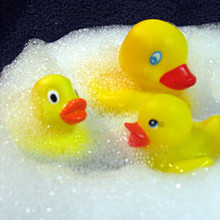Do bubbles act like insulation on the surface of your bath? Will it prevent the need for that toe-burning hot water top up? Find out in this QotW! Plus, we ask how solar sails stay aloft on simple sunlight...
In this episode

00:00 - Can bubble bath keep a bath warm for longer?
Can bubble bath keep a bath warm for longer?
We put this to Professor Eugene Terentjev from the Cavendish Laboratory at Cambridge University.
Eugene - Basically Steven asks this working on the assumption that a layer of bubbles would thermally insulate the top surface of the water, like a bubble wrap would insulate a hot or cold object. This is correct - it will reduce the heat loss through the top surface, both in straight diffusion of heat into the air and in water evaporation, which is a very efficient mechanism of cooling by phase transition. Of course, one has to have very stable long lived bubbles in this form covering the water surface, which can be achieved by the use of good surfactants and salts, although I don't know how good for your health all that would end up being! But my instinct tells me that both of these mechanisms of heat transmission and water evaporation off the top surface, whether insulated or not, are minor in the overall process of a bath cooling down. Let's conduct an imaginary experiment and cover the top surface of a hot bath with many layers of bubble wrap. I don't think the rate of its cooling will much diminish. I think the direct contact of water with the solid mass of the bath tub body is a much more efficient sink of heat. This is because the transfer of heat into the low density air is generally very poor. In fact, it is air filling the bubbles that is supposed to be the thermal insulator in Steven's original question, and we know how thin air cavities inside wool hairs make wool clothes so warm.
Diana - As techmind said on our forum, a layer of bath bubbles does indeed keep the bath warmer for longer but be wary of the old style cast iron bars. They're elegant, and will tend to conduct heat away from your water faster than a more modern acrylic bath will. But from pondering to practice, here's Dave Ansell to explain what he found experimentally.
Dave - To test this on a slightly smaller scale, I took two identical washing up bowls, filled them up 10 centimetres deep with water from a hot water tap, then I took some bubble bath, put it in one of them, frothed it up so you have a nice layer of bubbles over the surface, and left the other one. I then put two thermocouples, one in each bowl in exactly the same place then I waited to see what happens to the temperature. They both started at 44 degrees centigrade and after an hour, the one with bubbles was at 38 degrees centigrade, but one without any bubbles was down to 34 degrees centigrade. And when I looked at all the results, pretty much all the time, the one with bubbles was losing heat at just slightly more than half the rate of the one without any bubbles, which means that the bubbles are actually working as a very, very effective insulator. I think this result should work on a bath as well: on a bath, the surface is probably going to be slightly more important because relatively, there's less side compared to top and bottom on a bath, and I was using about the same depth of water as in a shallow bath. So you should find exactly the same thing happening when you bathe.









Comments
Add a comment